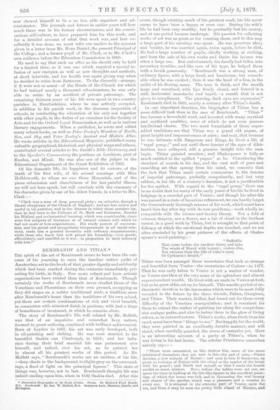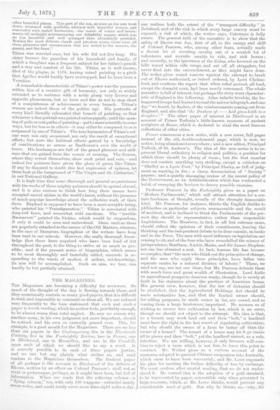REMBRANDT AND TITIAN.* THE spirit of the art of Rembrandt
seems to have been the out- come of his yearning to raise the familiar native paths of Amsterdam art to the levels of that greater dignity and sublimity which had been reached during the centuries immediately pre- ceding his birth, in Italy. Few more robust and keen artistic organisations have existed than that of Rembrandt. Though certainly the works of Rembrandt never rivalled those of the Venetians and Florentines on their own ground, occupying as they did stages on a nobler traditional scale, a tradition more after Rembrandt's heart than the traditions of his own school, yet there are certain combinations of rich and vivid breadth, in connection with minutest finish in portions, with just a tinge of homeliness of treatment, in which he remains alone.
The story of Rembrandt's life, well related by Mr. Mollett, was that of an impulsive and somewhat fiery nature, doomed to great suffering, combiued with brilliant achievement. Born at Leyden in 1607, his art was early developed, both in oil-painting and etching. He was soon married to the beautiful Saskia van Ulenburgh, in 1634; and her influ- ence during their brief married life was paramount over himself, and indeed, over his art, as he painted her in almost all his greatest works of this period. As Mr. Mollett says, "Rembrandt's works are an emblem of his life, -a-deep shade in the background, twilight-grey on the surround- ings, a flood of light on the principal figures." This state of things was, however, not to last. Rembrandt thought life was indeed smiling upon him, when in 1642 Saskia died. After this
* inustratert lifographka of the Great Artier. ?khan, By Richard Ford Math. B.A. Rembrandt. By Jno, W. Mollett, B.A. Sampson Low, Marston, Searle, and Blvington, event, though creating much of his greatest work; his life never seems to have been a happy or even one. During his wife's life he had been very wealthy, but he gradually lost his money,
and at one period became bankrupt. His passion for collecting works of art was as great as for creating them, and in this way
a large part of his earnings was spent. He was generous also ; and besides, he was married again, twice again, before he died. He had a large number of pupils, chiefly working at etching, and from the sale of his own works and theirs his income was often a large one. But unfortunately his family had fallen into
troubles, and like men of his type, he helped them with a lavish generosity. "Rembrandt was a strong man, of ordinary figure, with a large head, not handsome, but remark- able when he was excited ; then it was the head of a lion, in the midst of his flowing inane. The nose is thick, and the mouth large and unrefined, with lips firmly closed, and framed in fa stiff, horizontal moustache and beard,—a mouth that is not given to compliment. The piercing, dark eyes aro expressive." Rembrandt died in 1669, nearly a century after Titian's death, In one important direction, the biographer of Titian has a, more difficult task than in the case of Rembrandt. " Titian " has become a household word, and invested with many mystical and mythical qualities, some of which do not even possess intellectual charm. The two most formidable of those super- added traditions are that Titian was a grand old pagan, of great height and impressiveness of mien ; and next, that because he was intimate with Emperors and Kings, he lived a life of " regal pomp;" and not until these fancies of the ages of dilet- tantism have collapsed, will a genuine insight into the man begin. Titian painted creation ; and Shakespeare is fully as much entitled to the epithet "pagan" as he. Considering the standard of morals in his day, and the vast well of pure and ennobling art that sprang from his mind, we conceive that the fact that Titian made certain concessions to the fancies of imperial patronage, probably compulsorily, and but very seldom, in his life of a century's duration, is not a justification for the epithet. With regard to the "regal pomp," there can be no doubt that for many of the early years of his life he lived in lodgings in a crowded part of Venice ; and though his after-life was passed in a state of luxurious refinement, we can hardly forget the tremendously thorough manner of his work, which must have
taxed him day after day with its new problems,—work wholly in- compatible with the leisure-and-luxury theory. Not a fold of crimson drapery, nor a flower, nor a bar of cloud in the farthest corner, in a good work by Titian, but is wrought to that point of delicacy at which the emotional depths are touched, and we are often reminded by his great pictures of the effects of Shake,
speare's word-painting :—
" Daffodils That come before the swallow dares, and take The winds of March with beauty ; violets dim, But sweeter than the lids of J11110'8 eyes; Or Cytherea's breath."
Titian was born amongst those mountains that look so strange and beautiful from Venice—the mountains of Cadore—in 1477. That he was early taken to Venice is not a matter of wonder, as Venice was then at the very acme of its splendour and almost superabundant wealth. Ho lived with an uncle in Venice at first, but as he grevi older, set up for himself. This was the period of en-
thusiastic devotion to the harmonies which were to be most fully revealed in the future by the three friends, Palma, Giorgione, and Titian. Their master, Bellini, had found out for them every difficulty of the Venetian manipulation ; and it remained for them to extend the realms of painting far along the comprehen- sive antique paths, and also to imbue them in the glow of living colour, as in outward nature. Titian's works, when fresh from his easel, must have been "things to see." But happily for the world, they were painted in an excellently dUrable manner, and will stand, when carefully guarded, the stress of centuries yet. Here is an interesting account of a party at Titian's, when he was living in his last house. The scholar Prisciauese somewhat naively says :—
" There were assembled, as like desires like, some of the more celebrated characters that aro now in this city and of ours,—Pietro Aretiuo, a new miracle of Nature ; and next to him 11 Sansovino, as groat an imitator of Nature with the chisel as the master of the brush with his pencil ; and Nardi and myself, so that I made the fourth amidst so much wisdom. Here, before the tables were sot out, we spent the time in looking at the life-like figures in the excellent paint. ings, of which the house was full, and in discussing the real beauty and charm of the garden, which was a pleasure and a wonder to every one. It is situated in the extreme part of Venice, upon the sea, and from it may be seen the pretty little island of Murano, ma other beautiful places. This,part of the sea, as soon as the sun wont down, swarmed with gondolas, adorned with beautiful women, and resounded with varied harmonies,—the music of voices and instru- ments till midnight accompanying our delightful supper, which was no less beautiful and well arranged than abundantly provided. Besides the most delicate viands and precious wines, there wore all those pleasures and amusements that are suited to the seasons, the guests, and the feast."
Titian was married once, but his wife did not live long. His sister became the guardian of Ids household and family, of which a daughter was a frequent subject for her father's pencil, and a stay and comfort of his life. Titian, as is well known, died of the plague, in 1576, having raised painting to a pitch
that .pollee would hardly have overtopped, had he been born a Venetian.
A remarkable characteristic of Titian's power was the presence within him of a creative gift of harmony, not only so widely extended as to embrace with a noble grasp very diverse and opposite phenomena, but so keen and fine as not to stop short of a completeness of achievement in every branch. Titian's women are indeed those of the golden age. His portraits of every kind literally exhausted that branch of painting, so that whenever a fine portrait was painted subsequptly, until the open- ing of quite recent paths of painting—paths more scientific iu some ways, but far less so in others—it may either be compared to or is surpassed by one of Titian's. The true harmonies of Titian's col- our were not only occasional, not only the result of exceptional effort ; but were the habitual effects gained by a knowledge of combinations as serene as Beethoven's over the world of tones. His landscapes are full of the grand glamour and still- ness that are gained from the scenes of evening. The flowers, where they reveal themselves, show each petal and vein,—and indeed few painters have given the glory of green like Titian. If any be disposed to doubt this last expression of opinion, let them look at the foreground of The Virgin and St. Catharine," in our National Gallery. It is high time that some thorough and general acquaintance
with the works of those mighty painters should be spread abroad, and it is also curious to think how long their names have occupied sacred niches in the world's heart, without the presence .a much popular knowledge about the collective work of their lives. Raphael is supposed to have been a semi-seraphic being, who painted his " Transfiguration." Titian is associated with deep-red faces, and somewhat wild emotions. The "terrible Buonarroti" painted the Sistine, which would be stupendous, if only it could be seen and understood. Ideas such as these are popularly attached to the names of the Old Masters, whereas, in the case of literature, biographies of the writers have long been read in our schools. However, the really thorough know- ledge that those have acquired who have been fond of Art throughout the past, is the thing to strive at as much as pos- sible; and if the present series of biographies, which seems
to be most thoroughly and tastefully edited, succeeds in re- sponding to the wants of modest, if ardent, art-knowledge, its aim will be accomplished. Such an aim, we fear, can hardly be but partially attained.



































 Previous page
Previous page